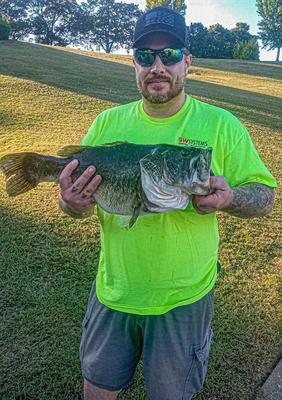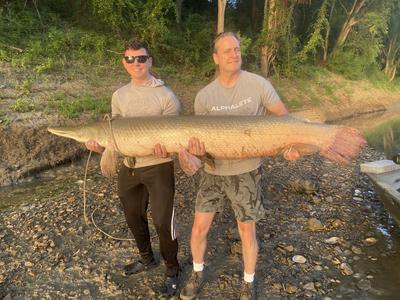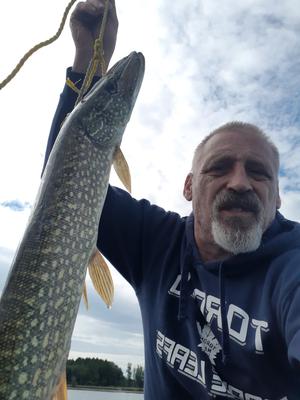The Dead Stick Fishing Tactic That Has Anglers Sticking It To Sluggish Bass
Dead stick fishing, or dead sticking for short, is the do-nothing angling technique.
Sounds simple, right? It should be. But there's more to this bass fishing tactic than just not doing anything.
To have more success catching those fish, including those bigger smallies and largemouth bass, there are a few important key factors that you should know and follow.
The dead stick method can be a bit tedious anyway, so why not make the best use of your time while out on the water.
Dead Stick Fishing Tackle
Dead Stick Rods
The bass fishing rod that you would use for dead sticking depends on what soft plastic baits, jigs or whichever type of lures that you are presenting.
Just as with any other time, your gear should match accordingly - rod, line, lure, weight, fish, cover.
So you really don't need to go out and buy a specialty fishing rod to dead stick with, unless you would like to of course. Otherwise, save your money.
I myself prefer to use fluorocarbon fishing line for most
instances when using soft plastics. A medium or medium-light spinning
outfit rigged with 6 to 8 pound test works great for me. And when
fishing with jigs, I'll go with 10-14 pound test fishing line on a
medium weight bait casting rod and reel.
Lures For Dead Stick Fishing
Soft plastic baits that are impregnated with salt and scent are the best choices for dead sticking. If the lure isn't scented, then you can just simply apply scent to them yourself. The same applies for jigs and creature baits as well.
The most common, and very effective, lure for dead sticking is the plastic worm. Bass fishermen have been dead sticking with them for decades, before anybody actually knew exactly what they were doing. Worm selection is off the charts. A senko rigged wacky style is a good choice, such as a Yum Dinger. There's also finesse worms, curly tails like the Culprit, paddle tails, ribbed styles, centipede, and the walking worm.
Some of my other favorite soft plastics also include creature
baits like a wooly bug, crawfish replicas, lizards, tubes, brush hogs,
grubs and even a zoom fluke.
Dead Stick Fishing Tips
When To Dead Stick
The best times to dead stick is when the fish aren't biting as they usually do. The easiest way to know this may perhaps to be at one of your hot spots or honey holes. You've probably thrown your entire tackle box at the bass and don't even see a follower.
You've caught a ton of fish there before, right? So you've tried cranking spinnerbaits, swimbaits, crankbaits, wake baits, jigging... different sizes, colors, styles... fast and slow... but still nothing. You know that there must be bass there. There has to be. There always is, right?
Well, bass do move around. Although, something might have pushed them off of that hot spot, or just turned them off from biting - extreme weather conditions, cold water temperatures, high winds, large fishing pressure.
The colder the water temperature is, then the more it should
be considered to dead stick. The temps can range from the low 50's down
into the mid 30 degrees. You can still dead stick in warmer water, but
you can get away with moving your bait around and continuously casting.
The bass should be much more active so you'll want to cover more water
at a faster rate.
Where To Dead Stick
It definitely helps to have a few of your own favorite hot spots that you usually catch fish from. But if it's a new and unfamiliar body of water that you've never fished at, then you obviously wouldn't have a go to honey hole.
You would then want to look for the key structure that are known to hold bass, such as weed lines, breaks, brush piles, lay downs, eddies, bridge pilings, docks and so on. You can also use your electronics to locate ledges, drop offs, points, rock piles and so forth.
Often times what results from a cold front or cold water
temperatures, some largemouth bass usually seem to
hang out and hide themselves buried in the underwater brush and weeds
where they have been feeding at over the past few days. Whereas smallmouth
bass will hang out right below the outside break of those
weed lines, and throughout crevices of steep drop offs, down all the
way to the base ranging to at least 20 feet in many lakes.
Dead Sticking Techniques
A wacky rig is excellent for dead stick fishing. The ends of the worm flutter on the fall, which creates a vibration that helps attract the attention of bass. The downside is that it can't be fished with through heavy cover. Therefore, you would need to bury the hook weedless style like a Texas rig.
You obviously would like for mister fishy to see the bait. The scent adds another attractant to the scene. The scent will begin to disperse from the bait during the decent, and will continue to as it sits there on the bottom.
Once you've got your bait sitting on the spot, just let it sit there. It may take a few minutes so you have to be patient. If a bass sees it, it should get curious enough to engulf it.
Often times the bait will tend to move on its own, which can also entice a fish to strike. I also give just a slight twitch of the rod tip to get the bait to move a little in the same spot that it's already sitting at. If that doesn't work, then I lift the bait up to about a foot or two and let it drop back down. When that isn't working, I'll drag it slowly across the bottom a couple of feet.
Be sure to keep the tip of your fishing rod pointing directly at your lure. Allow for a little slack in your fishing line, just enough so that the fish won't be able to sense it when they pick up the bait.
Additional Notes For Dead Sticking
Dead stick fishing isn't just a tactic that can only be used
for catching largemouth bass and smallmouth bass. This technique works
just as well to catch other freshwater fishing species such as walleye,
catfish, carp, panfish and more.
Good Luck and Stick It to 'em!
Find your favorite dead stick fishing baits and gear at Bass
Pro Shops HERE
Show Off Your Largemouth Bass
Cast us a line and tell us about your largemouth bass fishing.
As a matter of fact, you can share
your largemouth bass fishing pictures here.






Facebook Comments
Leave a comment, question or tip in the box below.